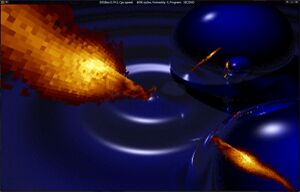DOSBox
 A Future Crew scene demo running in DOSBox 0.74.3. | |
| Developer(s) | Peter "Qbix" Veenstra, Sjoerd "Harekiet" van der Berg, Tommy "fanskapet" Frössman, Ulf "Finster" Wohlers |
|---|---|
| Initial release | July 22, 2002 |
| Repository | sourceforge.net/projects/dosbox/ (dosbox) https://github.com/dosbox-staging/dosbox-staging (dosbox-staging) |
| Written in | C++ |
| Operating system | There's ports for basically all of them. (Linux, macOS, Windows, Android, ChromeOS, BeOS, OS/2, Haiku, *BSD, Solaris, etc) |
| Type | Full PC emulator and MS-Dos compatible OS |
| License | GNU General Public License |
| Website | www.dosbox.com (dosbox) dosbox-staging.github.io (dosbox-staging) |
DOSBox is both a x86 and DOS emulator which lets you run old MS-DOS software on modern computers and phones running just about any operating system, DOSBox supports more operating systems and platform than most software. DOSBox emulates old PC hardware, it does not run any code natively, which is why it can run MS-DOS programs on just about any hardware/OS combination. DOSBox is mostly known for enabling you to play older games, but it is also very capable to run spreadsheet programs and all kinds of other programs. It will run the vast majority of all MS-DOS software perfectly.
DOSBox is available in two variants: Plain dosbox and dosbox-staging. "dosbox-staging" is a bit further ahead than plain "dosbox". It doesn't matter all that which one you use.
Installation
DOSBox is available for as good as all the Linux distributions. It can be installed with the usual method such as dnf -y install dosbox, dnf -y install dosbox-staging or emerge dosbox or by clicking apt://dosbox on Ubuntu.
Configuration
DOSBox stores it's configuration file in $HOME/.dosbox NOT $HOME/.config/dosbox as modern standards for configuration files dictate (placing configuration files in a dot folder in the home directory was how things were done in 2002 when DOSBox was initially released). However, dosbox-staging differs, it stores the configuration file in $HOME/.config/dosbox/dosbox-staging.conf.
You can run DOSBox once to get a default configuration file created in that folder. You will want to edit the default configuration and likely want to change windowresolution and output under [sdl] to something like
[sdl] windowresolution=1280x960 output=opengl
and you will also want to change the scaler= under [render] depending on your hardware. If it's decent you want
[render] scaler=advmame3x
Do keep in mind that MS-DOS games and other software was made for resolutions such as 320x200 and 640*480 when you set windowresolution=. Multiples of those that work well are
| resolution | zoom (assuming 640x480) |
| 960x720 | 1.5x |
| 1280x960 | 2x |
| 1600x1200 | 2.5x |
| 1920x1440. | 3x |
For audio you may want to change both rate= under [mixer] and oplrate= under [sblaster] to 48000. Check what your audio card is using with pactl list sinks to check if this is something you want to do. Leave it at 441000 (default) if that is what your sound card is using. Don't change one or the other, set both to 48000 is that is what your real sound hardware is using (which is probably is).
Gravis Ultrasound support is disabled in the default configuration file. It used to be the case that you needed the original GUS firmware to use Gravis Ultrasound audio. That is no longer the case with dosbox-staging, you can simply set gus = true in the [gus] section to enable it.
 |
Note: DOSBox does this very annoying thing where it insists that each minor new version should have it's own configuration file. You will need to copy your old configuration file to a new one in $HOME/.dosbox each time your distribution updates DOSBox thanks to the DOSBox developers being complete and utter morons in this regard.
DOSBox version 0.74-2 will create and use You should create a standard dosbox-staging differs, it stick with one configuration file located at |
Running DOSBox
A clip from Future Crew's Unreal II - The 2nd Reality demo running in DOSBox
Either start it from a terminal or alt+f2 in XFCE4/KDE with dosbox /file/path where the argument is a path to a folder you'd like to have as your C: drive. DOSBox will also give you a Z: drive with COMMAND.COM and friends. Example:
dosbox $HOME/OS/MSDOS
simply use . as argument to start it in the folder you're in,
dosbox .
Once in you can type help or help /allfor a list of DOS commands in case you forgot about DIR, CD and COPY.
SoundBlaster vs Gravis UltraSound
DOSBox can emulate the somewhat popular Gravis UltraSound card but you need some additional files to use that feature. While you can set that up[1] it's a bit of a hassle. The simpler solution is to use SoundBlaster for audio.
Fullscreen mode
In order to switch to fullscreen mode press ALT+ENTER. You fill find more keyboard shortcuts and information in the dosbox manual page.
Quick Warning About "DOS Collection" Archives
There are several very large not entirely legal to download collections of MS-DOS software available on websites such as www.retro-exo.com. Many of these collections contain the virus and some contain several.
We recommend using ClamAV to can DOS software collections and software collections in general. DOSBox provides isolation so DOS viruses can't just infect things outside their contained area and they can't run natively on GNU/Linux, so the risk is minimal. Scanning software from random sources with ClamAV is generally a good idea even so.
See Also
Video: Working on DOS in 2021.
Links
- The DOSBox website: www.dosbox.com
- The dosbox-staging website: dosbox-staging.github.io

Enable comment auto-refresher